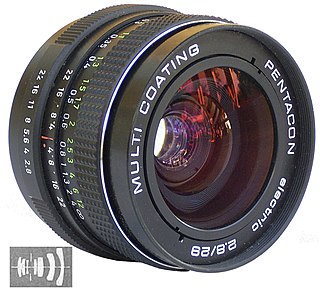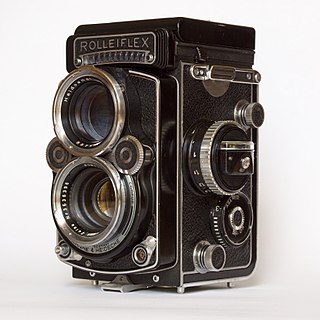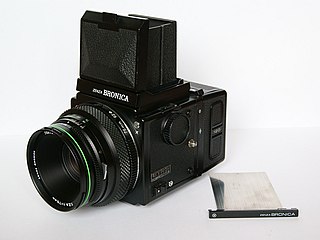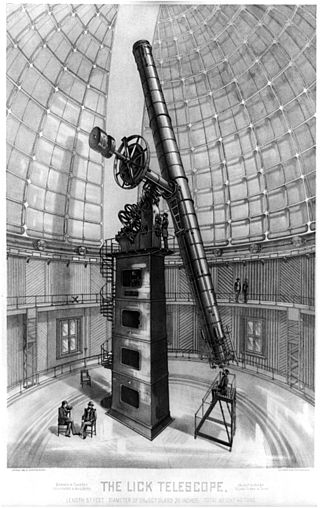Related Research Articles

Carl Zeiss AG, branded as ZEISS, is a German manufacturer of optical systems and optoelectronics, founded in Jena, Germany in 1846 by optician Carl Zeiss. Together with Ernst Abbe and Otto Schott he laid the foundation for today's multinational company. The current company emerged from a reunification of Carl Zeiss companies in East and West Germany with a consolidation phase in the 1990s. ZEISS is active in four business segments with approximately equal revenue in almost 50 countries, has 30 production sites and around 25 development sites worldwide.

Pentax Corporation was a Japanese camera and optical equipment manufacturer, and currently, it exists as the Pentax Life Care Business Division of Hoya's medical endoscope business, as well as the digital camera brand of Ricoh Imaging, a subsidiary of Ricoh.

In film and photography, a prime lens is a fixed focal length photographic lens, typically with a maximum aperture from f2.8 to f1.2. The term can also mean the primary lens in a combination lens system. Confusion between these two meanings can occur without clarifying context. Alternate terms, such as primary focal length, fixed focal length, or FFL are sometimes used to avoid ambiguity.

Praktica was a brand of camera manufactured by Pentacon in Dresden in eastern Germany, within the GDR between 1949 and the German reunification in 1990. The firm Pentacon was divided in mainly two parts and sold after German reunification. Schneider Kreuznach and Noble bought parts of it. Pentacon is a Dresden-based company in the optical and precision engineering industry, which was at times a major manufacturer of photo cameras. The name Pentacon is derived on the one hand from the Contax brand of the Dresden Zeiss Ikon Kamerawerke and Pentagon, because a pentaprism for SLR cameras developed for the first time in Dresden has this shape in cross section. Today's PENTACON GmbH Foto- und Feinwerktechnik is still based in Dresden. It is part of the Schneider Group, Bad Kreuznach. Pentacon is the modern-day successor to Dresden camera firms such as Zeiss Ikon; for many years Dresden was the world's largest producer of cameras. Previous brands of the predecessor firms included Praktica, Exa, Pentacon, Zeiss Ikon, Contax, Ica, Ernemann, Exakta, Praktiflex, and many more.

Rolleiflex is a long-running and diverse line of high-end cameras originally made by the German company Franke & Heidecke, and later Rollei-Werke.

Panavision Inc. is an American motion picture equipment company founded in 1954 specializing in cameras and lenses, based in Woodland Hills, California. Formed by Robert Gottschalk as a small partnership to create anamorphic projection lenses during the widescreen boom in the 1950s, Panavision expanded its product lines to meet the demands of modern filmmakers. The company introduced its first products in 1954. Originally a provider of CinemaScope accessories, the company's line of anamorphic widescreen lenses soon became the industry leader. In 1972, Panavision helped revolutionize filmmaking with the lightweight Panaflex 35 mm movie camera. The company has introduced other cameras such as the Millennium XL (1999) and the digital video Genesis (2004).

Jos. Schneider Optische Werke GmbH is a manufacturer of industrial and photographic optics. The company was founded on 18 January 1913 by Joseph Schneider as Optische Anstalt Jos. Schneider & Co. at Bad Kreuznach in Germany. The company changed its name to Jos. Schneider & Co., Optische Werke, Kreuznach in 1922, and to the current Jos. Schneider Optische Werke GmbH in 1998.

Rodenstock GmbH is a German manufacturer of optical lenses and eyewear. The company, which was founded by Thuringian Josef Rodenstock in 1877, is headquartered in Munich.

Bronica also Zenza Bronica was a Japanese manufacturer of classic medium-format roll film cameras and photographic equipment based in Tokyo, Japan. Their single-lens reflex (SLR) system-cameras competed with Pentax, Hasselblad, Mamiya and others in the medium-format camera market.
The Kodak DX6440 is a model of digital camera produced by the Eastman Kodak Company. It is part of the company's EasyShare consumer line of cameras, and is compatible with the Kodak camera docks and printer docks. Its 1/2.5" CCD image sensor gives a 4 megapixel image, while the fully retractable Schneider-Kreuznach lens has a focal length range equivalent to 33mm–132mm on a 135 film camera, which is a 4× range.

The Pentax K-mount, sometimes referred to as the "PK-mount", is a bayonet lens mount standard for mounting interchangeable photographic lenses to 35 mm single-lens reflex (SLR) cameras. It was created by Pentax in 1975, and has since been used by all Pentax 35 mm and digital SLRs and also the MILC Pentax K-01. A number of other manufacturers have also produced many K-mount lenses and K-mount cameras.

Alvan Clark & Sons was an American maker of optics that became famous for crafting lenses for some of the largest refracting telescopes of the 19th and early 20th centuries. Founded in 1846 in Cambridgeport, Massachusetts, by Alvan Clark, and his sons George Bassett Clark (1827–1891) and Alvan Graham Clark (1832–1897). Five times, the firm built the largest refracting telescopes in the world. The Clark firm gained "worldwide fame and distribution", wrote one author on astronomy in 1899.

Anamorphic format is the cinematography technique of shooting a widescreen picture on standard 35 mm film or other visual recording media with a non-widescreen native aspect ratio. It also refers to the projection format in which a distorted image is "stretched" by an anamorphic projection lens to recreate the original aspect ratio on the viewing screen. The word anamorphic and its derivatives stem from the Greek anamorphoo, compound of morphé with the prefix aná.

Întreprinderea Optică Română, often abbreviated by the acronym IOR, is a major optics company established in 1936 in Bucharest. IOR produces military and civilian-grade optics and associated equipment for export and domestic production. The company is known in North America particularly for its riflescopes, binoculars and other sporting optics, which often accompany Romanian military equipment sold on the North American market, such as the PSL rifle.

DxO Labs is a privately owned photography software company. It was founded in 2003 by Jérôme Ménière, former CEO of Vision-IQ. The company's headquarters are in Paris, France.
Ira Alan Tiffen is an optics designer and glass artist who worked at the Tiffen Company from 1973 to 2004. He has been the recipient of both an Academy Award and an Emmy Award for his technical achievements in motion picture photography and video imaging.

A cine lens, short for cinema lens, is a specialized optical device designed specifically for motion picture production. Unlike standard photographic lenses, cine lenses are built to meet the rigorous demands of filmmaking, offering precise control over focus, aperture, and other key elements essential to cinematic storytelling. Known for their superior build quality, smooth operation, and ability to maintain sharpness and clarity across various focal lengths, cine lenses are engineered for high-end professional use in film and television production. They often feature consistent aperture settings, minimal focus breathing, and reliable manual controls, making them indispensable tools for cinematographers seeking to achieve the artistic vision and technical excellence required in the world of visual storytelling.

Friedrich Deckel GmbH, also known as F.Deckel, was a German company founded by Friedrich Deckel and Christian Bruns in Munich as Bruns & Deckel in 1903. Its most famous product is the Compur line of leaf shutters used on many photographic lenses starting from 1911. Bruns and Deckel previously had worked together at C. A. Steinheil & Söhne; Bruns was an inventor responsible for developing leaf shutters while Deckel was a laboratory mechanic.

Rodenstock Photo Optics traces its origins to a mechanical workshop founded in 1877 by Josef Rodenstock and his brother Michael in Würzburg, Germany. The company relocated to Munich by 1884 and became an important manufacturer of both corrective lenses for glasses and camera lenses by the early 1900s. These two lines began to diverge in the 1960s as the center of photographic lens manufacturing shifted to Japan; the ophthalmic business continued as Rodenstock GmbH while the remaining camera lens business was repositioned to serve the large format and industrial precision optics markets, then spun off in 1996 as Rodenstock Präzisionsoptik. Since then, the precision optics brand has been acquired in succession by LINOS Photonics, Qioptiq Group, and Excelitas Technologies (2013).
References
- ↑ "In Memoriam: Steven Manios Sr. (1938-2021)". The American Society of Cinematographers . Retrieved 2024-10-14.
- 1 2 3 4 Ramos, Dino-Ray (2021-01-07). "Steven Manios Sr. Dies From Covid-19: Former Owner Of Century Precision Optics Was 82". Deadline. Retrieved 15 June 2024.
- 1 2 3 "About Schneider". Schneider Kreuznach. Retrieved March 22, 2018.
- ↑ "The Academy Awards Database". awardsdatabase.oscars.org. Retrieved 15 June 2024.
1991: To CENTURY PRECISION OPTICS for the opto-mechanical design and development of the Canon/Century Precision Optics Zoom Lens. [Lenses and Filters]
- ↑ Fauer, Jon (6 January 2021). "Steven Manios Sr. 1938-2021 - Film and Digital Times". Film and Digital Times. Retrieved 15 June 2024.